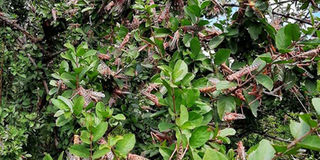Aerial spraying of desert locusts in northern Kenya begins

Some of the desert locusts which have invaded Gurar in Wajir North. The government has acquired at least 3,000 litres of a special chemical that will be used for aerial spraying of swarms of desert locusts that have invaded parts of Northern Kenya, Government Spokesman Cyrus Oguna has said. PHOTO | BRUHAN MAKONG | NATION MEDIA GROUP
What you need to know:
- The locusts crossed the Elwak border point between Kenya and Somalia on December 28, 2019.
- All the six constituencies in Mandera have been invaded by the deadly insects.
- Food and Agriculture Organisation notes that locust invasion is swift and incredibly destructive.
The government has acquired at least 3,000 litres of a special chemical that will be used for aerial spraying of swarms of desert locusts that have invaded parts of Northern Kenya, Government Spokesman Cyrus Oguna has said.
The aircraft conducting the aerial sprays and personnel from Agriculture and Interior ministries were dispatched to the affected counties of Mandera, Marsabit and Wajir.
The locusts crossed the Elwak border point between Kenya and Somalia on December 28, 2019.
HAND-HELD SPRAYERS
According to Mr Oguna, the spraying, which started Saturday, also entails the use of hand-held sprayers on the ground, which are being handled by only authorised personnel from the ministry.
The team on the ground will also help locate the insects to ensure a controlled aerial operation.
“Aerial spraying is quite a scientific undertaking that calls for serious handling of the chemical to ensure that its use is effective.
The government’s intention is to ensure that the locusts do not spread to other parts of the country,” Mr Oguna said Saturday during a media briefing.
SIX COUNTIES
All the six constituencies in Mandera have been invaded by the deadly insects. They have spread to Tarbaj, Wajir East and Wajir West constituencies in Wajir County and parts of Marsabit as the government keeps a keen eye on the neighbouring counties of Garissa and Isiolo.
The locusts are a collection of swarming phases of certain species of short-horned grasshoppers and can live between three to six months and up to 10 months with favourable environment.
A swarm can contain up to 150 million insects per kilometre square and can migrate up to about 130 kilometres in a day.
DESTRUCTIVE
Food and Agriculture Organisation notes that locust invasion is swift and incredibly destructive.
It also estimates that 500,000 locusts can weigh approximately one tonne, eating as much as 10 elephants or 25 camels or even 2,500 people.
They are usually solitary but under certain climatic circumstances, they become more abundant and aggressive, forming deadly swarms.
The government’s action comes after politicians from the affected areas led by National Assembly Majority Leader Aden Duale (Garissa Township) and Eldas MP Adan Keynan warned that urgent action is required.
Mr Oguna was, however, unable to quantify the nature of the destruction already caused by the locusts, with Mr David Mwangi, the head of Plant Protection Services Division at the Ministry of Agriculture saying the extent of damage will be known after the containment.
DAMAGE ASSESSMENT
“We haven’t done the damage assessment yet but what we know is that trees and bushes with the exception of crops have been affected. Right now we are focused on containing the locusts first then we verify the nature of damage at a later stage,” Mwangi said. A global early warning and preventive control system against the desert locusts has been in place since November last year.
Although there have complaints that the government reaction was lackadaisical, Mr Oguna noted that serious interventions were taken immediately to deal with the situation.
Part of these interventions included monitoring and establishing the breeding grounds of the locusts.
“I want to assure the country that we haven’t slept on this issue. It is important to note that the President ordered that urgent measures be undertaken to contain the situation as early as possible to ensure there is no danger to human and animal food,” said Mr Oguna.
The team from the ministries will be required to get regular briefs from the security team on the ground to guide the aerial sprays due to the fact that the region is prone to security threats.
DANGER OF SPREADING
Mr Duale warned that if nothing is done, there is a danger that the locusts will spread to other parts of the country.
“This is a serious crisis that must be addressed urgently. God has given us rain that saw vegetation sprout and now the locusts have descended on it, fomenting danger to our own food security as well as our animals,” Mr Duale said.
According to Mr Keynan, the desert locusts caused a scare in the neighbouring Ethiopia before the government moved in swiftly to contain the situation. “While some were annihilated, the others spread to northern Kenya,” Keynan said.
The desert locusts are not common in Kenya. Their origin is at the Red Sea region that has seen countries such as Ethiopia, Eritrea, Yemen, Sudan among others affected.
The last time they were reported in Kenya was in 2007 in Mandera and Wajir.
They are a major pest around the world threatening the agricultural sector and affecting livelihoods of one tenth of the world population, who occupy about 20 per cent of land on earth.





